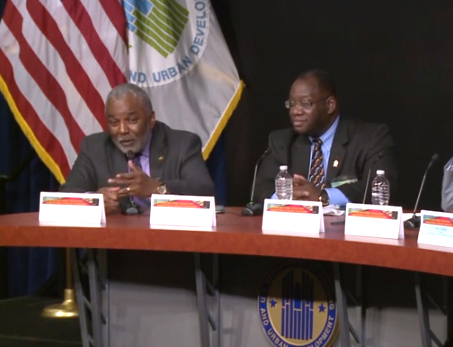IN THIS ISSUE:
Grantee Spotlight: HUD-Funded E2 Initiative Helps Entrepreneurship Flourish in Jersey City
Anchor Institutions: HBCUs Leading the Way to Community Transformation
Illinois Institute of Technology’s Community Outreach Initiatives
Anchor Institutions: HBCUs Leading the Way to Community Transformation

Dr. David Swinton, president of Benedict College (left) and Larry Salley, executive director of the Benedict-Allen CDC (right) discussed their organizations’ efforts over the last 15 years.
On April 15, 2014, HUD’s Office of University Partnerships (OUP) hosted an event that showcased community and economic development activities in low-wealth communities of two historically black colleges and universities (HBCUs). By maximizing available resources and nurturing collaborations with federal, state, and local entities, the efforts of the two institutions demonstrate best practices in building capacity and strengthening their surrounding communities. Representatives from Benedict College in Columbia, South Carolina; Coppin State University in Baltimore, Maryland; and their affiliated community development corporations (CDCs) spoke about the importance of building community partnerships and the results of their work, representing a well-established 15-year program and a relatively new 4-year program, respectively.
Building Community and Sharing Success
Dr. David Swinton, president of Benedict College, began the discussion by describing the conditions and issues that prompted the school to adopt its role as both an anchor and an engaged partner in the local community. Swinton has long recognized that, to attract students to the college, both the campus and the adjacent community would need to be revitalized and well maintained. In 1995, under Swinton’s leadership, the Benedict-Allen Community Development Corporation was created to be a catalyst for change by combining public and private resources to address community concerns.
To establish credibility, Swinton focused first on campus improvement efforts, addressing issues of litter and landscaping to beautify the grounds. After making noticeable improvements to its campus, the college approached the community to address blight, abandonment, and safety concerns beyond the institution’s borders.
In 2000, Larry Salley was selected to build upon Swinton’s accomplishments when he became the executive director of the Benedict-Allen CDC, a joint venture of the community, Benedict College, and Allen University, another HBCU in Columbia. Salley cited a 1995 city report that enumerated the challenges found in the Waverly/Read Street area near Benedict College’s campus. Determined to alleviate the community’s high concentrations of poverty, unemployment, and substandard housing, the CDC created the Read Street revitalization plan, which set the framework for strengthening housing and economic conditions in the area and improving residents’ quality of life.
Guided by the revitalization plan and assisted by the city of Columbia, philanthropic institutions, banks, and residents, the Benedict-Allen CDC has undertaken numerous projects in the last 15 years to improve housing, economic development, and human capital. To date, the CDC has:
- Acquired 30 substandard or vacant houses and lots for redevelopment at a cost of more than $900,000;
- Constructed a $2.7 million, 25,000-square-foot business development center;
- Developed a 3,500-square-foot community technology center serving both students and area residents at a cost of more than $500,000;
- Provided job training and placement assistance to more than 475 low-income men, women, and youth at a cost of more than $5.5 million; and
- Provided housing and credit counseling and financial literacy services to approximately 2,300 clients.
Source:
David Swinton and Larry Salley. 2014. “HBCU-Led Community Development a Model for Change: Benedict-Allen Community Development Corporation,” presentation at Anchor Institutions: Historically Black Colleges and Universities Leading the Way to Community Transition, 15 April.
×As a result of these and other activities, the Waverly/Read community has shown significant improvements on a number of social and economic fronts. Average house values have risen by 18 percent since 2002. With the revitalization plan’s data as a basis, substandard housing has decreased from 48 to 21 percent. Also since 1995, median household income has risen from $12,564 to $33,090 and unemployment has dropped 10 percentage points to 21 percent.
The CDC’s executive director also indicated that the development of quality affordable housing has been an effective tool in promoting community stability and reducing crime. A park once perceived as dangerous at night was improved with new facilities (including tennis courts where youth tennis lessons are held and a walking track) and is now shared by the community and Benedict College. A bar with a history of gun violence, drug activities, and prostitution was acquired and renovated as the Benedict College Community Learning Center, a space for technology education that both addressed an important local need and eradicated a long-time problem.

Dr. Mortimer Neufville, president of the Coppin University, Dr. Gary Rodwell executive director of the Coppin Heights CDC (center), Dr. Kirk Crowley, president of the Coppin Heights CDC (right) described their organizations’ efforts at community and economic development.
To further address crime in the area, Benedict College moved its safety services office into the community. In addition, the Benedict-Allen CDC established a YouthBuild USA chapter to give local youth an alternative to crime by providing general education assistance and construction skills training. Much of this work, which has catalyzed further development in the area, was made possible through a partnership with HUD, whose HBCU grant program provided approximately $5.4 million to Benedict College over the past 14 years to implement community and economic development activities.
Source:
David Swinton and Larry Salley. 2014. “HBCU-Led Community Development a Model for Change: Benedict-Allen Community Development Corporation,” presentation at Anchor Institutions: Historically Black Colleges and Universities Leading the Way to Community Transition, 15 April.
×Source:
David Swinton and Larry Salley. 2014. “HBCU-Led Community Development a Model for Change: Benedict-Allen Community Development Corporation,” presentation at Anchor Institutions: Historically Black Colleges and Universities Leading the Way to Community Transition, 15 April.
×Building Foundations for the Future
In contrast with the well-established the Benedict-Allen CDC, Coppin State University in Baltimore, Maryland and the Coppin Heights CDC, which began their community development work in 2010, are still in the process of establishing community relationships and producing initial results. Dr. Gary Rodwell, executive director of the Coppin Heights CDC, introduced the president of the university, Dr. Mortimer Neufville, who spoke about the importance of engaging with the community and building solutions that include developing commerce and a stable economy in addition to housing.
Neufville observed that universities and communities must work together to make physical improvements that create a positive impression when prospective students and their parents visit the campus. Referring to the university’s approach to ensuring community support of development efforts, Neufville noted that “To be fully engaged, you must practice reciprocity.” He also emphasized the importance of balancing the needs of both students and the community in the community development and engagement processes.
Dr. Kirk Crawley, president of the Coppin Heights CDC, defined community as “a family of neighbors with diverse interests working toward a shared vision” and emphasized the need for anchor institutions to understand the community’s agenda. The CDC has served as an intermediary between the university and the community, ensuring that the needs of both were valued and respected. Rodwell spoke about how the CDC and the community have sought out partners to address significant challenges, including poverty, housing vacancy, and limited access to healthcare.
Through collaboration with residents and other anchor institutions, the CDC has developed homes near the university and renovated a park to address safety concerns. The Coppin Heights CDC is also planning a $12.5 million Center for Healthcare and Healthy Living. Helping the CDC are national partners such as the National Association for Equal Opportunity in Higher Education, the Historically Black Colleges and Universities Community Development Action Coalition, and SRP Development (a development management firm affiliated with Smoot Construction, one of the oldest African American construction companies in the country). The center will include a pharmacy, dental office, behavioral health clinic, primary care facility, and nutrition office. In addition to these projects, the CDC is in the early stages of developing a 5.8-acre urban farm that will provide job training and teach residents about healthy eating.
Learning and Leading
Although the two anchor institutions bring different levels of experience in community development and engagement, they share a belief in the necessity of collaboration and consensus building with the community. The projects that were presented reflect the diverse issues facing these communities and the creativity these institutions and their partners have applied in achieving positive change. Both parties suggested that, with the help of numerous resources and the ability to build allies within the community, they have created development projects that both benefit those living in the community and attract people to their respective HBCUs.


